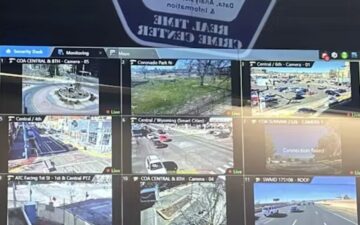Kimberly Przeszlowski in The Conversation:
 In 2021, a driver in Albuquerque, New Mexico, ran a red light, striking and killing a 7-year-old and injuring his father. The suspect fled the scene and eventually escaped to Mexico. Using camera footage and cellphone data, the Albuquerque Police Department’s real-time crime center played a crucial role in identifying, apprehending and charging the person at fault. The driver was ultimately sentenced to 27 years in prison, providing a measure of justice to the grieving family.
In 2021, a driver in Albuquerque, New Mexico, ran a red light, striking and killing a 7-year-old and injuring his father. The suspect fled the scene and eventually escaped to Mexico. Using camera footage and cellphone data, the Albuquerque Police Department’s real-time crime center played a crucial role in identifying, apprehending and charging the person at fault. The driver was ultimately sentenced to 27 years in prison, providing a measure of justice to the grieving family.
Real-time crime centers are specialized units within police departments that use the latest technology to monitor public spaces and record incidents. The New York City Police Department was the first to institute a real-time crime center in 2005.
Real-time crime centers often focus on video surveillance, using closed-circuit television systems, license plate scanners, body cameras worn by officers and drone cameras. The centers sometimes also include gunshot detection and computer-aided dispatch systems, live or static facial recognition, cellphone tracking and geolocation data, and access to probation, parole and arrestee information. Police departments are adding the latest innovations, such as video analytics driven by deep learning artificial intelligence, to identify objects and assess subjects’ behavior.
More here.
Enjoying the content on 3QD? Help keep us going by donating now.
